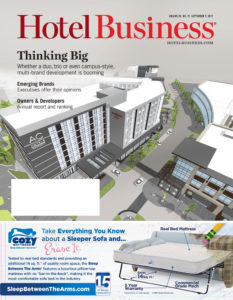ORLANDO, FL—Finding and retaining talent is one of the biggest challenges for hospitality companies. It’s also a critical aspect of the job. While the right workers are important for companies in any industry, in hospitality—where employees have direct interaction with guests and are the ones conveying the brand message and personally contributing to the travel experience—it’s essential. So how does an industry notorious for high turnover keep its employees happy? Chris Whitlow, CEO of Edukate, a financial wellness advisory company, weighs in.
“The workforce, across the board, is a competitive field,” he said. “Everyone is looking at what ancillary or fringe opportunities and benefits there are at organizations and, more importantly, how they can be part of a culture that cares about their contribution. With the job growth we’ve seen, it really is a market for the job applicant being able to find the place they want to work. Businesses need to be cognizant of that and think about how their brand of what they’re selling to their customers and the story and culture they’re creating for their employees align so as to strengthen that relationship and attract the right individual.”
One of the biggest challenges for employers is stagnating wages. “We can look at statistics across many industries—not just the hotel space—and see that wages aren’t dramatically increasing. The burden of self-preservation and finances is falling more on the employee and because of that, turnover is increasing,” he said, noting that employees are also trying to find the right culture fit. “Conversely with that, you also have organizations that are trying to sell something to their customers and want to hire the person who is representative of being able to drive that experience to the customer. You’re then challenged with trying to find a very competitive group of individuals who can fit the line of business you’re offering.”
This creates a problem for employers, Whitlow said: “If I can’t pay them more, what are some of the unique ways that I can motivate and incentivize them to want to work here and want to treat our customers in the way that we expect them to be treated?”
The answer? “It starts with treating your employees that way,” Whitlow said. “We’re starting to see nontraditional benefits become more recognized in the industry because if wages aren’t increasing, if people are turning over more and we can’t provide pensions, we need to give something that’s going to establish that culture—and nothing says more to an employee that we care about you other than the way you’re treating them.”
According to Whitlow, benefits and wellness can be broken down into four categories: physical health, mental health, financial health and the overall, 360-view of the employee. “In each one of those areas, there are unique benefits being brought to the table,” he said. For example, on the healthcare side, employers are implementing more flexible spending accounts and health reimbursement accounts to give the employee more control over health benefits “because they realize it has a huge impact on the overall physical health of that employee.”
As for mental health, he said, “You’re seeing mindfulness campaigns and meditation campaigns, introductions of things like yoga where employees can partake and focus on how they can clear their mind and operate more efficiently in and out of their lives.”
The financial space has traditionally been driven by the 401k plans that replaced pensions. And while those aren’t going away, Whitlow noted alternative products—like access to credit, help repaying student loans, incentives for employees to build emergency funds, and providing financial planning and budgeting—are starting to become part of the financial wellness narrative. “Employers are trying to alleviate some of the financial stressors that an employee is going to face in their day-to-day lives,” Whitlow said.
He also noted that the hotel industry has one of the lowest participation rates in retirement plans. “There tends to be this notion that our rate is low and that’s normal, but it doesn’t mean it’s supposed to be that way. There’s a lot of things that can be done to increase those participation rates,” Whitlow said. “Employees who don’t take full advantage of the benefits offered to them are more likely to be financially stressed than those who do. Just the mere fact of having a low participation rate in your retirement plan could be very suggestive that a lot of employees are under some financial pressure. Try to figure out what the underlying cause is to why people aren’t participating in those programs, get that information from that employee and implement a strategy to help create opportunity.”
For many people, it’s often a language barrier. “There are a lot of hospitality workers where English is not their first language, but all the benefits information is written in English. If that’s the case, how can we help alleviate that problem, either using technology or innovative solutions from the benefits carriers, where you can start to engage those employees in a language they’re familiar with,” Whitlow said.
“And then when you think about 360, you’re seeing lots of cultural engagement techniques—asking employees for feedback, trying to have better company outings and culture, really engaging the employees around what’s happening at the organization,” Whitlow said. “If I’m an employer, I want to be thinking about that: What are those benefits we’re offering, what does that say about us as a company and how does that align with the culture we’re offering customers? In the hospitality space where you’re providing an experience and expecting that the employees interact with customers to provide them with what that organization’s brand is, its very important—more so than in other industries where there’s not a direct interaction with the customer on a day to day basis.”
According to Whitlow, there are two major mistakes companies make when it comes to wellness for employees. “There’s a tendency amongst employers to focus on highly compensated employees because there’s this notion the ones we’re paying most have a greater impact on the bottom line,” he said. “But in hospitality, you have a lot more rank-and-file employees than highly compensated employees. So if you’re creating benefits or culture, providing things, thinking about how we can serve the corporate office because that’s where your highly comps are, don’t. You need to be focusing on that person on the bottom rung, how can we make their experience better because they’re tackling the challenges of life with a lot less, and it doesn’t mean their situation is less complicated. In some ways, it’s more complicated. If we’re able to connect with that person, then it’s going to translate all the way up to the top.”
The other word of caution he had is to not assume things are working. “You have to be reiterating and rethinking about what is the current meta of benefits now,” he said. “A lot of times these programs take time to put in place and maintain, and oftentimes people don’t want to readdress them, but go back and survey employees, understand what’s being utilized and what’s not, what can you get rid of, where can you innovate, and then make sure those things align with your brand.” HB


